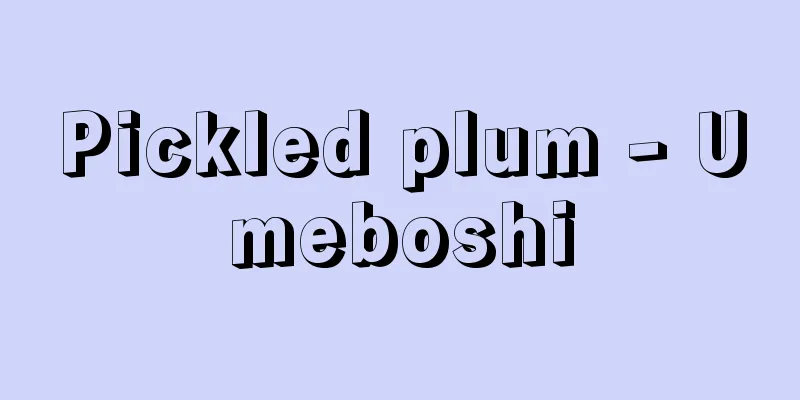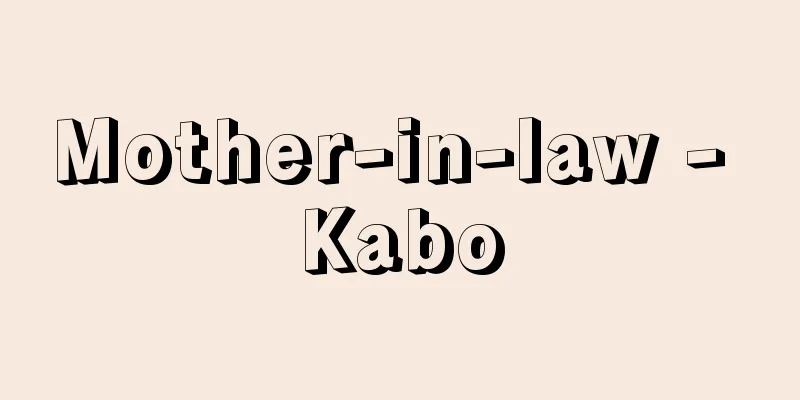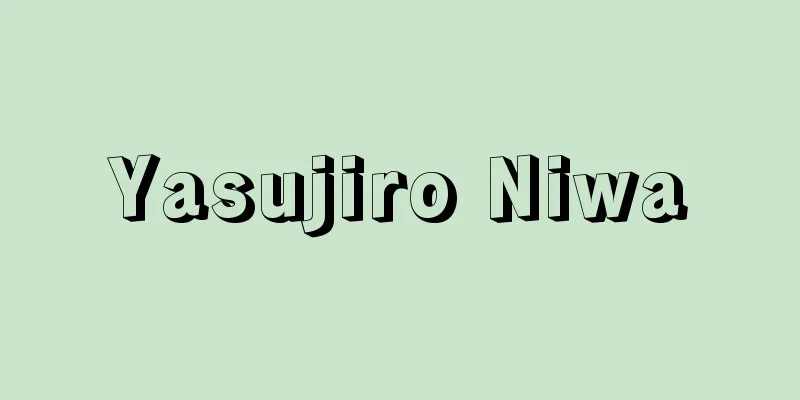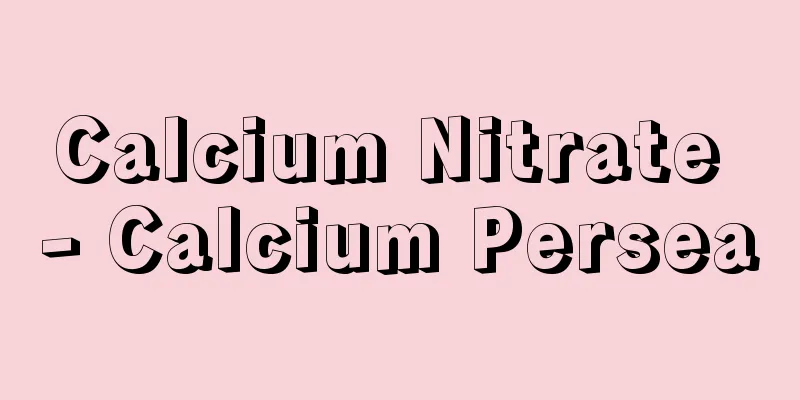Pickled plum - Umeboshi

|
Plum fruits are salted and dried in the sun. They are usually dyed red with red perilla. They have been used as food since ancient times, but they are also often used as medicine and have been valued as a portable food for emergencies. [Tomomi Kono and Midori Otaki] historyUmeboshi were first recorded in the mid-Heian period, but it is believed they were probably made before then. According to an old record, Emperor Murakami (reigned 946-967) recovered from an illness after eating umeboshi and kelp tea. In the Kamakura period, banquets for samurai were "ouban," which was served with jellyfish, smashed abalone, umeboshi, salt, and vinegar. In the Edo period, umeboshi became popular among the general public as well. However, umeboshi up until the Edo period were not colored with shiso. [Tomomi Kono and Midori Otaki] VarietiesThe best varieties of plums are generally those with thick flesh and thin skin. Small plums are also used. Shirakaga, which is widely cultivated, is considered to be of good quality, and other varieties include Bungo, Yoro, and Nanko, with Akebono being used in Odawara, Kanagawa Prefecture. Shinano plums are used for small plums. Plums are cultivated throughout the country, including Wakayama Prefecture, Nagano, Gunma, Tochigi, Yamanashi, Kanagawa, Nara, Tokushima, and Fukuoka Prefectures. In recent years, many are imported from China and other countries, which have thin flesh and thick skin. [Tomomi Kono and Midori Otaki] How to pickleGreen plums for making umeboshi are sweeter and more flavorful when they are slightly yellowish. Each household and region has its own traditional method for pickling umeboshi, and the techniques often vary slightly. The general method is to first soak the plums in water overnight. The plums will turn slightly yellow and the seeds will come off easier. After draining the water, the plums are alternately packed into a container with salt (about 20% of their weight), then the lid is put on and a weight is placed on top. After 4 to 5 days, clear water (ume vinegar) will rise, but the mixture should be left like this for 3 to 4 weeks. Pick the perilla leaves, wash them, and rub them lightly with salt, discarding the first juice. Rub them with salt again, then add the plum vinegar from the container, and return the bright red plum vinegar to the original container. Place the salted perilla leaves on top of the umeboshi container, cover it as before, and leave it there until the summer doyo. Choose a sunny day during the Doyo period, spread the plums out on a large sieve or bamboo basket, spaced apart from each other, and dry them day and night for three days and nights. Exposing them to the night dew will soften the flesh of the plums. You can also put them back in the plum vinegar overnight and dry them again the next day. Make sure they do not get wet in the rain. The dried umeboshi are placed in a container, with the plums and red perilla alternating, red ume vinegar added on top, the inner lid put on a light weight, the opening tightly sealed, and stored in a cool, dark place. The flavor will have blended in about six months and they will be ready to eat, but they can be stored for around 10 years. Reduced-salt umeboshi are made by reducing the salt by 20 to 40 percent and adding shochu instead, but this often doesn't work well as the umeboshi go moldy and spoil. [Tomomi Kono and Midori Otaki] kindsThere are several types, including Kanto-style umeboshi, which are light brown and sprinkled with white salt without using red perilla, Odawara-style shiso-maki umeboshi, which are umeboshi wrapped in red perilla leaves and pickled again, and umeboshi sprinkled with bonito flakes. There are also many umeboshi named after the region where they are produced. There are also umeboshi that are made without drying, and seasoned umeboshi that are low in salt and have added seasonings. [Tomomi Kono and Midori Otaki] Ingredients and benefitsThe strong sourness of umeboshi comes from citric acid, which is the main component, and it is said to have many health benefits. However, it is high in salt, so care should be taken not to consume too much. The main benefits of umeboshi, which have been said since ancient times, include relieving seasickness and car sickness, stimulating appetite, preventing food poisoning in the summer, and recovering from or preventing fatigue. All of these can be seen as benefits of the citric acid. In the Kamakura period, umeboshi were valued as military food for samurai, and were highly valued as a miracle cure for shortness of breath. Also, because their sour taste helps relieve mental stress, some people eat umeboshi before sports games or television appearances. [Tomomi Kono and Midori Otaki] useThe liquid that seeps out when pickled plums are called ume vinegar; white ume vinegar is used as a type of vinegar, while red ume vinegar with added red shiso is used to make red pickles. Ume bisio is made by straining umeboshi plums and thinning them with mirin. It is used in sushi and salads. Alternatively, the flesh of umeboshi plums is ground, strained, thinned with sugar, mirin, soy sauce, etc., and mixed with various ingredients to create a dish called ume niku ae. Ume niku vinegar is also used, made by adding sugar, sake, dashi stock, etc. to the strained ume flesh and thinning it. In addition, umeboshi plums are added to simmered blue-backed fish such as sardines to improve the flavor, and there are also dishes in which the umeboshi themselves are desalted and then made into tempura. Umeboshi soup is made by placing the flesh of a umeboshi plum and thinly sliced ginger in a bowl, pouring hot soup stock over it, and adding a small amount of soy sauce, and kombucha is made by pouring boiling water over small plums and kelp, and is often used at celebratory meals. [Tomomi Kono and Midori Otaki] [Reference] | | |Since ancient times, it has been used as a portable food for emergencies. It is said that plums with thick flesh and thin skin are best. There are many varieties of plums used, and red perilla is commonly used, but the pickling method often varies slightly depending on the region and household. ©Shogakukan "> Pickled plum Source: Shogakukan Encyclopedia Nipponica About Encyclopedia Nipponica Information | Legend |
|
ウメの実を塩漬けして天日で干したもの。通常、アカジソを使い、紅色に染められている。古来、食用とされてきたが、薬用としての利用も多く、また非常時の携帯食品としても重用されてきた。 [河野友美・大滝 緑] 歴史梅干しのことが記されているのは平安中期であるが、おそらく、それ以前から梅干しはつくられていたと思われる。記録によれば、村上天皇(むらかみてんのう)(在位946~967)の病気が梅干しと昆布の茶で回復したというのが古い。鎌倉時代になると、武家の饗応(きょうおう)は「垸飯(椀飯)(おうばん)」で、これにクラゲ、打ちアワビとともに梅干し、塩、酢が添えられた。江戸時代には一般庶民にも用いられるようになった。しかし、江戸時代までの梅干しは、シソで着色されていなかった。 [河野友美・大滝 緑] 品種梅干しに用いる品種は、肉厚で、皮が薄いものが一般によいとされている。また小梅も使用される。広く栽培されている白加賀が品質としてよいとされ、このほか、豊後(ぶんご)、養老、南高(なんこう)などがあり、神奈川県小田原では曙(あけぼの)が用いられる。小梅は信濃梅(しなのうめ)が用いられる。ウメの産地は和歌山県をはじめ、長野、群馬、栃木、山梨、神奈川、奈良、徳島、福岡県など全国で広く栽培されている。なお、近年は中国などからの輸入品が多く、これは肉が薄く皮が厚い。 [河野友美・大滝 緑] 漬け方梅干し用の青ウメは、幾分黄みを帯びたもののほうが甘味があって味がよい。梅干しの漬け方は、各家、各地方などで伝統のものがあり、手法がいくらか異なることが多い。一般的な漬け方は、まずウメを一晩水に浸す。ウメは、いくらか黄色くなり、種離れがよくなる。水切り後、ウメの重量の20%前後の塩を、ウメと交互に容器に詰め、押し蓋(ぶた)をして重石(おもし)をのせる。4~5日すると澄んだ水(梅酢)があがるが、このまま3~4週間置く。 アカジソは葉を摘み取り、水洗いしたのち軽く塩でもみ、最初の汁は捨てる。さらに塩もみしたのち、梅酢を容器からとって加え、鮮紅色になった梅酢をもとの容器に戻す。塩もみしたアカジソの葉は、梅干しの容器の上部に入れ、もとのように蓋をして、夏の土用までそのまま置く。 土用の晴天の日を選び、梅を大きなざるか簀(す)の上に広げ、1粒ずつ離して並べ、昼夜通して三日三晩干す。夜露に当てることで、梅の実の肉質が柔らかくなる。なお、夜間、もとの梅酢の中にいったん戻し、翌日ふたたび干してもよい。雨には絶対にぬれないようにする。 干し上げた梅干しは、容器に梅とアカジソを交互に入れ、上から赤い梅酢を加え、中蓋をして軽く重石をし、口をきっちりと包み、冷暗所に保存する。半年くらいで味がなじみ食べられるようになるが、10年くらいは十分保存できる。 減塩梅干しは、塩分を2~4割減らし、かわりに焼酎(しょうちゅう)を加えるなどしてつくるが、カビが生えたり、腐敗したりしてうまくできないことが多い。 [河野友美・大滝 緑] 種類アカジソを使用せず、白く塩を吹いた薄茶色の関東風梅干し、梅干しをアカジソの葉で巻き、さらにもう一度漬けた小田原のしそ巻き梅干し、かつお節をまぶした梅干しなど、いくつかの種類がある。また、産地ごとに、その地方の呼び名をつけた梅干しも多い。このほか干さないでつくる梅漬け、塩分を控え調味料を加えた調味梅干しなどもある。 [河野友美・大滝 緑] 成分と効用梅干しの強い酸味はクエン酸によるもので、この酸が主体となり、効用がいろいろいわれている。しかし塩分が多いため、とりすぎには注意が必要である。 おもな効用としては、昔からいわれているものに、船酔い、車酔いによく、食欲を進め、夏の食あたりの防止、疲労回復や、その防止があげられる。いずれもクエン酸の効用とみてよい。鎌倉時代には武士の兵食として重視され、息切れの妙薬として重宝された。また酸味は、精神的ストレスの緩和に役だつため、スポーツの試合前や、テレビなどの出演前に、梅干しを口に入れる人もある。 [河野友美・大滝 緑] 利用ウメを塩漬けにした際、しみ出してくる液体を梅酢といい、白梅酢は酢の一種として利用し、アカジソを加えた紅梅酢は紅色の酢漬けをつくるときに使う。梅びしおは、梅干しを裏漉(うらご)しにかけ、みりんで延ばしてつくる。すし、和(あ)え物に用いる。また、梅干しの肉をすり、裏漉しし、砂糖、みりん、しょうゆなどで延ばし、各種材料を和えたものを梅肉和えという。裏漉しの梅肉に砂糖、酒、だし汁などを加えて延ばした梅肉酢も利用する。このほか、イワシなど背の青い魚の煮物に梅干しを加えて味をよくしたり、梅干しそのものを塩抜きしたのち、てんぷらにする料理もある。梅干しの身と、細切りのしょうがを椀(わん)に入れ、熱いだし汁を注ぎ、少量のしょうゆを加えた梅干しの吸い物、小梅と昆布に熱湯を注いだ昆布茶(こぶちゃ)は、祝い膳(ぜん)などに用いられる。 [河野友美・大滝 緑] [参照項目] | | |古来、非常時の携帯食品として重用されてきた。肉厚で、皮が薄いものがよいとされている。用いるウメの品種もさまざまで、アカジソを使用するのが一般的だが、漬け方は各地方や家庭により若干異なることが多い©Shogakukan"> 梅干し 出典 小学館 日本大百科全書(ニッポニカ)日本大百科全書(ニッポニカ)について 情報 | 凡例 |
<<: Umeboshi sea anemone - Umeboshi sea anemone
Recommend
Separate post - Bechinousho
It was one of the household institutions for the r...
Ruri Tateha (Blue Admiral)
This butterfly belongs to the order Lepidoptera, ...
Honda Tadakatsu
Year of death: October 18, 1610 (December 3, 1610)...
Kilimanjaro (English spelling)
A brand of coffee that is produced in the foothil...
Mycosterol
…Cholesterol is almost nonexistent in plants, and...
Shiozawa [town] - Shiozawa
An old town in Minamiuonuma County, southern Niiga...
Sedum oryzifolium (English name) Sedumoryzifolium
… [Hiroshi Yuasa]. … *Some of the terminology tha...
Fire Tornado
This refers to the whirlwind that occurs with a la...
Chen Sheng and Wu Guang (English spelling)
? - 208 BCE Leaders of a peasant revolt in the lat...
Peso
…By the beginning of the 17th century, prices in ...
Neuroleptanalgesia
... By injecting nerve blockers and analgesics in...
Brushed Nishiki
…It is a weaving technique that has been seen sin...
Asama tan - Asama tan
... In addition, Mount Haneyama (1,256m) near Kyu...
Tell Abu Shahrayn (English spelling)
…It was also important as a port near the Persian...
Possession
...When possession is viewed from the perspective...









